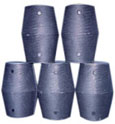 |
 |
Starex can provide you with high quality UHP, SHP and HP Graphite Electrodes to improve your cost per ton. Contact us today to see how we can reduce your melting costs and help you remain strong in today’s competitive global economy. |
||||||||||||||||||
 |
Graphite electrodes are highly conductive and resistant to high temperature and spallation. Graphite is a brittle material, with limited flexibility. Handle your graphite electrodes carefully, following the suggestions and directions provided here: »» Download a PDF version of the Operational Manual
Storage and Transportation
To join graphite electrodes prior to use
Use of Electrode Holders The white mark at each end of the graphite electrode indicates the joining parts of the electrode. Do not allow the electrode holder to nip outside the white marks. Doing so can damage the internal surface of the socket or cause crackle or nipple shear (SKETCH 5). Useful TipsUsing a steel electrode cover to prevent the upper part of electrode group from being oxidized by flame coming from the electrode inserting holes. The cover can prevent the electrode from being polluted by the ash coming from the electrode inserting holes. To keep joining parts from loosening, place a nipple-pin on the nipple. At normal temperatures, the pin will remain in a solid state. As the temperature rises, the melting nipple pin will bind the electrode and nipple together. |
Phone:
| ||||||||||||||||||
| Copyright ©2012 Starex Inc. | Web by ADS | ||||||||||||||||||||
 Operational Manual
Operational Manual



